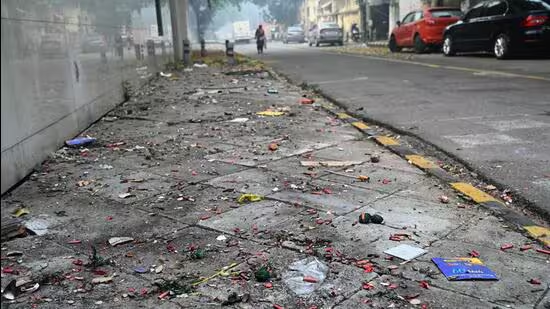On Diwali night, Delhi saw the Supreme Court’s curbs on firecracker use reduced to little more than a formality. Despite Delhi Police’s tall claims of “maximum deployment” and “strict enforcement,” the city erupted in explosions and light shows well past the 10pm deadline, with the revelry and pollution stretching into the early hours of Tuesday – and again later that evening.
The Supreme Court had allowed the sale of only NEERI-certified green crackers for three days, from October 18 to 20, and limited their use to two one-hour windows – from 6 to 7 am and 8 to 10 pm on October 19 and 20. The Delhi Police had announced large-scale enforcement plans, with personnel stationed in neighbourhoods, markets, and public areas to ensure compliance.
But by Monday night, the reality was far from those claims.
Delhi Fire Service (DFS) data offered a glimpse of violations – between 12am and 6am on Tuesday alone, its control room received at least 41 fire-related calls linked to the bursting of crackers.
Noise-monitoring data from the Delhi Pollution Control Committee (DPCC) also told the same story, showing decibel levels far above permissible limits in almost every district of the city.
To assess the extent of enforcement, HT contacted the deputy commissioners of police (DCPs) in all 15 districts. Fourteen of them either refused to comment or did not respond to calls and messages.
Only one senior officer – DCP (Rohini) Rajeev Ranjan – acknowledged that violations had occurred. “Violations were reported in the area and we took action against offenders. Several people were prosecuted,” he said, though he declined to share figures.
In contrast, DCPs across south, central, east, north, west, and outer Delhi either remained silent or declined to comment, even as DPCC data clearly showed violations in their jurisdictions.
In south Delhi, DCP Ankit Chauhan offered no response, despite noise levels touching 69.7 decibels at DPCC’s Sri Aurobindo Marg station around 11pm – far above the 45 dB night-time limit set by DPCC.
In southeast Delhi, where levels touched 79.8 dB at Lajpat Nagar, DCP Hemant Tiwari also did not respond. Residents expressed frustration. “It’s been impossible to sleep or even breathe since Monday evening,” said Anil Chowdhury, a software engineer from Nehru Nagar. “Firecrackers went on till 4 am. How are people still not realising this is poisoning all of us?”
In New Delhi, DCP Devesh Mahla did not respond to queries. Noise levels near India Gate and Connaught Place were around 60 decibels – unusually high for the area. In central Delhi, DCP Nidhin Valsan remained unreachable even as the Karol Bagh monitoring station recorded the city’s highest noise reading at 93.5 decibels.
The silence continued across the city’s police ranks. Sharad Bhaskar, DCP (west), gave no comment though noise levels around Pusa touched 69.5 dB. Sachin Sharma, DCP (outer), also did not respond despite residents reporting high noise across Paschim Vihar and Nangloi. Hareshwar Swami, DCP (outer-north), explicitly refused to comment even as Narela and Alipur recorded 66.2 dB.
In east Delhi, DCP Abhishek Dhania did not respond despite readings of 75.5 dB in Patparganj and Preet Vihar. Raja Banthia, DCP (north), also remained silent though decibel levels in Civil Lines and Kashmere Gate touched 67.1.
In Dwarka, DCP Ankit Singh offered no comment despite levels peaking at 75.1 dB. In northwest Delhi, DCP Bhisham Singh did not respond though Jahangirpuri and Ashok Vihar recorded 77.4 dB. In Shahdara, DCP Prashant Gautam stayed silent even as his district’s monitoring station recorded 84.1 dB – one of the loudest across Delhi.
In southwest Delhi, DCP Amit Goel also did not respond, and with the RK Puram monitoring station non-functional that night, residents themselves described the chaos. Gurpreet Bindra, president of Vasant Vihar’s RWA, said, “There was noise till midnight despite police patrols. It was impossible to control.”
Rajesh Panwar, who heads a federation of Vasant Kunj RWAs, said, “The noise continued till 3 or 4 am. I didn’t see a single police patrol. People are waking up with headaches and sore throats.”
Ashish Mishra, DCP (northeast), was also unreachable, though residents reported widespread bursting of firecrackers through the night.
For many Delhiites, the indifference of enforcement agencies was as suffocating as the smog itself. Residents’ associations accused the police of acting as “mute spectators” to violations, despite repeated complaints. “When we called the police, they said they lacked manpower,” said Arvind Kaila, president of Kailash Colony RWA. “The Delhi government, too, did nothing to create joint enforcement teams or involve residents in monitoring.”
Atul Goyal, head of the United Residents Joint Action (URJA), which represents over 2,500 RWAs, said enforcement was “an utter failure.” “There was no monitoring of whether crackers were green or not. People were bursting crackers till 2 or 3am. The rules were reduced to a joke.”
Experts said the night’s air quality was made worse by stagnant weather conditions. Mukesh Khare, an IIT-Delhi professor and air pollution specialist, noted, “While the bursting of crackers is an obvious source, meteorological conditions largely determine how pollution disperses or accumulates. Low wind speeds and cold temperatures trap pollutants close to the ground.”
Images are for reference only.Images and contents gathered automatic from google or 3rd party sources.All rights on the images and contents are with their legal original owners.

